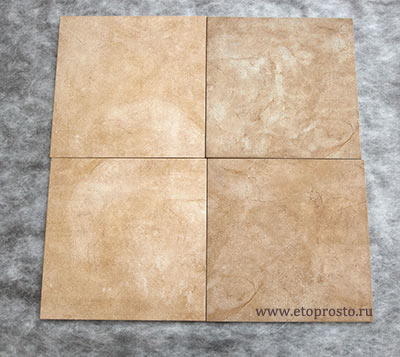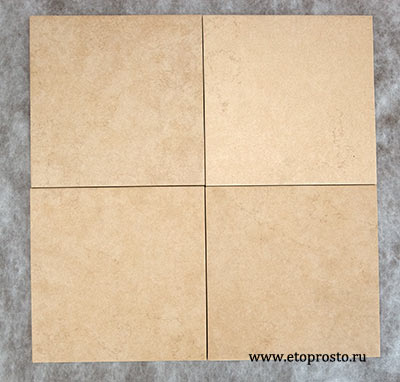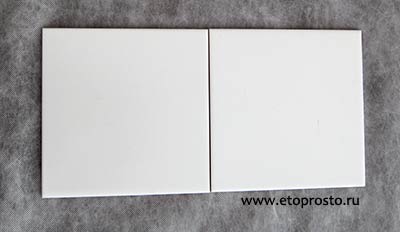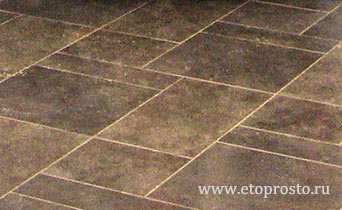
However, sometimes when you are laying the tiles, some part of the tiles become unusable (beats out, cuts off crookedly, etc.). There are also cases where a heat-insulated floor becomes unusable and some of the tiles have to removed, or six months after a repair, you decide to rearrange the furniture in the bathroom and add some tiles in places where they did not exist before. My neighbors kept boxes of remains of tiles lying idle for two years in their corridor. These tiles were on different occasions discarded by the tenants living at the apartment. On the third year, it was found out that the plumber so crookedly installed the bathtub that the entire drain from the washing machine began to pour on it. The bathtub had to be put on a pedestal using those same tiles that were melancholically gathering dust at the corridor.
Is it possible to buy an additional tile if this is really needed? Basically, yes. Except for two little pitfalls.
 |
Are tiles of different shades somehow separated at the factory? Yes. At the exit of the conveyor at the factory sits a man who checks the whole batch and separates tiles of the same color by shades. These shades are then displayed on the boxes and storage documents. The shades can be designated entirely anyhow as you please. However, as a rule, it's still a kind of a combination of letters, numbers and a punctuation mark. For example, shades can be designated as B45, A14, 001, 12, 17, 16C, 41G, s52A, z50B, or just a point.
The picture above shows tiles of shades D50, D52, H58 and L54. The two similar tiles on the left are D50 and D52. The tiles on the right are H58 and L54. Numbering of shades usually begins with the lightest tile (in this case it would be shade A) and continues to the darkest tile. In the photo, L (lower right tile) is the darkest tile.
 |
|
The lightest tile has shade C57,
while the other three tiles have shades E56, E58 and F57
|
At the very first glance, only the top right tile stands out among the rest. The others are quite similar. However, when you look at the photo closely, it becomes noticeable that the lower left tile has a slightly different color (however, it is very insignificant for it can even not be displayed at all on your monitor).
 |
 |
 |
 |
Even in this poor-quality picture, on the left you can see that one of the sizes is different in brightness. Moreover, you should not confuse the difference in shades and material, which was specially created artistically to ensure no other tiles repeated the other. An example is shown in the picture on the right. It shows four tiles with totally different visual appearance, despite the fact that they are in one collection, have the same color and shade. Generally, the shade matching is irrelevant for such tiles since the important thing is to emphasize the variety of the shades. A totally different matter is the floor on the left in the photo, where the darker tiles immediately catch the eye and violates the overall design.
It is most likely that when you first bought the tiles, you did not pay attention to their shade. Moreover, if you threw away all the boxes, then it will be impossible to by yourself determine what shade the tiles had. The only way is to call the seller and, if the tiles were purchased not long, ask which shade was sold to you. It is only a 15% probability that the seller will be able to help you out in this situation. However, if you still have the boxes with you, then you can find the shade on the tile box.
Below is a picture of a box containing Italian-made tiles. We specially took a more complicated case – a foreign-made box, since in Russian, everything is written in Russian, and thus it will be much easier to understand the meaning of what is written.
 |
Let's take a look at box A in the picture. It has a lot of different numbers and letters. How can one understand what they mean?
If you look closely, you will notice that the box has the words scelta (meaning "grade" in Italian), tono (shade), calibro (caliber), articolo (article) and codice (code). Normally, under every word there should be its corresponding value, but in this case, the inscriptions are shifted and thus the caliber value is located under "shade", while the shade value is located between "shade" and "grade". We drew red arrows on the picture so that you can see which value corresponds to which parameter.
It is indicated on the box that it contains first grade tiles, with shade D61 and caliber 7. In addition, the tile code (0070466), collection name (Life), and color name (vela) are all indicated. For now, we are only interested in the shade. The tile shade is D61, meaning that you need to buy tiles of shade D61. If the seller does not have the tiles, then you should go for closer shades – D62 and D60, and other D. If there is no D, then go for letters that are closest to D – C or E. If they are also not available, then take the closest to D61 that is available (do not forget to check the caliber. See the article Floor tile sizes).
Now let's look at box B. Tiles in this box have shade A52 and caliber 7. That is, by size, the tiles are suitable, but by shade, they are not very suitable.
Tiles in box C have shade D61 and caliber 8. The shade is exactly what we want because it matches the shade of our original box A. Therefore, we can confidently buy it. The caliber difference of 1 mm is negligible.
Below are more examples of boxes, on which the tile shade is indicated. The left image shows different tile codes (86315 and 86341), which have different shades (M57 and S59). But can different tiles have the same shade?
 |
 |
|
tiles in boxes of different shades |
|
Yes, they can, for example, when 4 tiles 30x30 are produced from tile 60x60. In this case, 60x60 and 30x30 will have the same shade. Another example is when the edges of a usual tile are cut at 90 degrees to ensure a joint-to-joint laying almost without a seam. Then, the resulting rectified tile will have the same shade as the original tile. Let's consider another example where the tiles are polished to give them a shine. In this case, both the matte and glossy tiles will have the same shade. And the last example – when the batch of tiles of several sizes are produced simultaneously from the same components. Sometimes, it turns out that at the end you obtain tiles of similar shades. In this case, tiles 30x30 and 30x60, for example, will have the same shade. Moreover, this is exactly what you need if you are going to lay a complex pattern of a combination of several tile sizes. This is so because if you take tiles of different shades, the floor will gleam with different shades and not with different sizes of the tiles, and this will slightly spoil the artistic appearance of the room.
When calling the store, you will need to accurately name all the information you recorded. Then act as follows: if this tile is available, ask for the required shade. If the shade is not available, ask which shade is available and choose the closest to your tile.
If the seller does not have your tile, try to find a company that delivers or produces that tile. If the company does not have the tile, ask the company to order the tile specially for you, specifying the shade and caliber. In this case, if the tile is produced, it is likely it will be brought to you in multiple of boxes. However, the delivery may take up to three months. Therefore, when making your first purchase, think very well whether it is better to buy tiles in extra to avoid going up and down in the future in search of additional suitable tile.
Also check the following articles:
What is a tile caliber and why does it matter when buying tiles?




